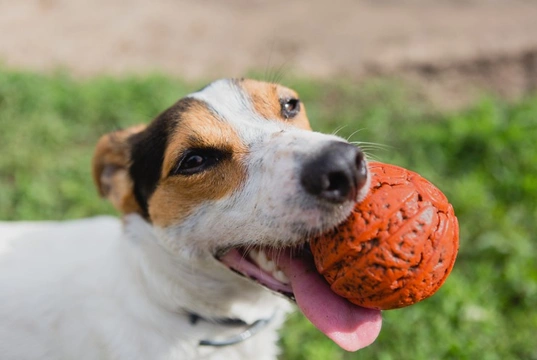
Six things that could potentially choke your dog
Dogs explore the world around them with their mouths, and tend to mouth, hold and chew at things to get a feel for them. Some dogs are only ever happy when they have something to carry around too, like a ball or toy – and this is particularly common in retrieving dog breeds like the flat coated retriever.
Dogs are also very good at getting themselves into hot water with things and not always displaying much common sense when it comes to the things that they pick up and chew, eat, or carry about – which means that we as dog owners must be vigilant about keeping our dogs safe and healthy, and preventing them from eating or chewing on things that might be harmful to them.
Achieving this will come down to a combination of training – training your dog to leave things, and not pick up random objects or steal food – and removing the opportunity for injury or getting into problems. However, even if your dog is well trained and you are very vigilant, accidents can happen, and often very quickly – such as choking.
Choking poses a real risk to the health of dogs just as it does for people, and this is compounded by the fact that if your dog knows they shouldn’t have something and that you are going to try to take it from them, they may attempt to eat it quickly or run off with it, exacerbating the issue. However, knowing how to identify some of the most common choking hazards for dogs can help you to keep your dog safe and keep dangerous things well out of their reach.
In this article, we will look at six innocuous-seeming objects that can pose a choking hazard to your dog – and why.
Another dog’s toys
All dogs need a range of toys and things to play with, which should include toys to chase and pursue, things to chew, and interactive toys to play with as part of a game with you or another dog. You might think that making sure you buy good quality dog toys that are made for the purpose will ensure that such toys are safe and suitable for your dog – and this is true as long as you pick toys that are the right size for your dog, and supervise their play.
However, just as dogs come in a huge range of different shapes and sizes, so too do their toys – and a ball or other toy that is just the right size for a smaller dog can easily become a choking hazard for a larger dog. Take care if your dog plays with a friend or if you have more than one dog of different sizes that your dog doesn’t accidentally inhale or choke on a toy designed to suit a smaller mouth.
Children’s toys
Children’s toys might look a lot like dog toys to your dog, but they are designed to a completely different standard and specification, and are not fit to withstand the rigours of a playing or chewing dog.
Many toys for children are composed of or contain small parts, which can easily be inhaled, ingested or swallowed, and that may pose a choking hazard too.
Bones
All dogs love bones, but not all bones are good for dogs. You should not give your dog just and old bone, but instead pick one that is sold as safe for dogs, whether that be a raw bone or a prepared one. The bone should also be the right size for your dog’s mouth and not too small, and you should never leave your dog unsupervised with it.
Cooked bones from your own meals are not good for dogs, as they tend to splinter easily – particularly in the case of very small bones, which is why cooked chicken bones in particular should never be given to dogs.
Hard treats and chews
Rawhide chews, dental treats and things like chicken’s feet, jerky, or pigs’ trotters are all really popular with dogs, providing them with something to gnaw on and in some cases, to help to keep their teeth clean.
However, chews of these types are not suitable for all dogs, and if your dog doesn’t have strong, healthy teeth and gums, they can actually damage their mouths on chews of this type. Additionally, if your dog is impatient or hard on their toys and chews, they may try to swallow the chew or crunch it up into smaller pieces, which can pose a potential choking hazard.
Sticks
Sticks and twigs aren’t good toys for dogs, despite the ease with which dogs find them when out and about. Both sticks and twigs can splinter, snap and crack, causing a potential choking hazard and also, increasing the risk of injury if your dog jumps to catch a toy and comes into contact with a sharp point or jagged edge.
Certain types of prepared foods
A great many dogs enjoy healthy snacks like apple or carrot, and these are much better for your dog than treats or fatty snacks. However, the shape and size you cut such foods into must be appropriate for your dog’s size and build, to prevent choking.
If you give your dog bits of carrot, for instance, it should be cut into small squares and not discs, as these discs are just the right size to cover and occlude the wind pipe in dogs. Certain other innocent-seeming foods like cooked spaghetti may also pose a choking hazard in rare cases too, as the length and thin breadth of spaghetti means that your dog might partially swallow a large strand rather than chewing it up, which can cause choking.



